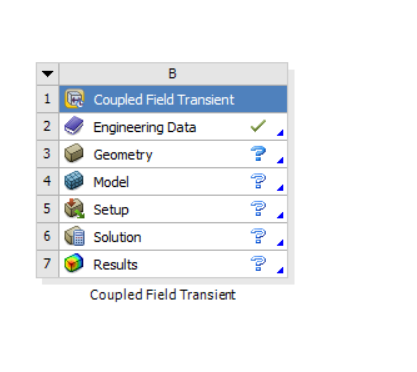TAGGED: contact, pressure, thermal-conductance
-
-
June 5, 2023 at 2:51 pm
henriquegpo
SubscriberHello,
In an old post I was taught how to implement, via APDL, a TCC as function of contact pressure. Unfortunately, the colleague that was helping me didn't check my further question, and I was not able to solve it on my own.
So I would like to ask here once again: how can I properly set this up? I mean, I went until the point that I've configured the specific contact the way I want, and now I have to run a combined thermo-mechanical analysis. I am familiar only when I first calculate a temperature distribution in a Steady-State Thermal, and pass this result to a Static Structural to see the deformations due to temperature change.
My problem now is that I want the opposite: first I run the static structural, from which I get the contact pressure as a result. Then, I would like to pass this contact pressure to a Thermal analysis, using the contact pressure result as an input to calculate the correct thermal conductance. I tried several ways of doing it, but none of them worked.
Could someone please give me some advice on how to do so?
Thanks!
Henrique -
June 6, 2023 at 1:15 pm
Chandra Sekaran
Ansys EmployeeI would suggest using coupled thermal-structural analysis such as below. You add 'Coupled field transient' or 'Coupled field static' and then in Mechanical you can indicate that you want both thermal and structural physics taken into account. You can find documentation on this at https://ansyshelp.ansys.com/account/secured?returnurl=/Views/Secured/corp/v231/en/wb_sim/ds_coupled_field_analyses.html
-
June 7, 2023 at 1:36 pm
henriquegpo
SubscriberDear Chandra Sekaran,
Thank you for the info. I never used coupled field systems before. I tried to run it on my workstation but I couldn't. It seems that the amount of computational resources for running it are way higher for this system, right? I am now trying to set it up in a HPC cluster, and I will report back as soon as I can get some results out of it.
Is there a way of minimizing computational efforts in this kind of system?
-
June 8, 2023 at 8:45 am
Rohith Patchigolla
Ansys EmployeeHere are some tips for reducing the computational efforts for Coupled Field analysis:
- Use linear mesh
- Use Iterative Solver + Coupling Option --> Thermal Strain --> Weak in the properties of Physics Region
- Coarsen the mesh where not necessary to have a fine mesh
-
June 13, 2023 at 2:58 pm
henriquegpo
SubscriberDear Patchigolla,
Thank you for tips! I was able to reduce my model and run it on my normal PC. I'm still not getting the behavior I expected thoug. I will investigate a little bit further, and I am probably coming back with further questions next week.
Thanks for now!
-
August 18, 2023 at 7:08 pm
Jared Valois
SubscriberHi Henriquegpo,
I am attempting to perform a similar study to you (varying TCC as a function of contact pressure determined through static structural), and I too have been unsuccessful so far. It has been a few months since your last post, so I am wondering if you were able to find a solution to this problem.
Thanks
-
August 21, 2023 at 1:07 pm
henriquegpo
SubscriberHello Jared,I did manage to go a bit further with this study, but unfortunately I could not get completely what was happening behind the scenes, so I simplified my approach in the end.For example, the units were not making sense to me. I defined a fixed TCC value via the contact details of let's say 0.01W/mm².K and obtained a specific result. To get that same result but with TCC values defined via APDL, I needed to scale that value 1000 times, so 10 instead of 0.01. I honestly could not understand where this difference comes from. Anyway, I just got my test data and scaled by 10^3.The result from my simulation was kind of non-intuitive for me, but it showed that with the bodies expansion, the contact pressure was getting close to uniform again, and than using a variable TCC didn't make too much of a difference in this case.Than to creat a simpler model, I just discretized my contact area in smaller areas alternating between high TCC and low TCC, and used a Steady State Thermal to check the temperature distribution, followed by a Static Structural to check if the non uniform temperature distribution would also influence in the deformation profile.Don't know if that report helps you anyhow, but I hope so! Also, if you could share a bit more of your analysis we may be able to discuss and see what's going on there.Cheers
-
- The topic ‘Thermal Contact Conductance as function of Contact Pressure’ is closed to new replies.



-
3139
-
1007
-
918
-
858
-
792

© 2025 Copyright ANSYS, Inc. All rights reserved.








